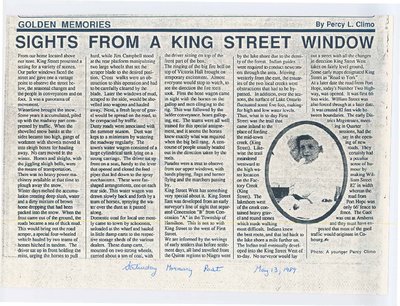By Percy L. Climo
From our home located above our store, King Street presented a setting for a variety of scenes. Our parlor windows faced the street and gave one a vantage point to observe the street below, the seasonal changes and the people in conveyances and on foot. It was a panorama of movement.
Wintertime brought the snow. Some years it accumulated, piled up with the roadway part compressed by traffic. When the shoveled snow banks at the sides became too high, gangs of workmen with shovels moved it into sleigh boxes for hauling away. No cars moved in the winter. Horses and sleighs, with the jingling sleigh bells, were the means of transportation. There was no heavy power machinery available at that time to plough away the snow.
Winter days melted the accumulation creating deep slush, water and a dirty mixture of brown horse dropping that had been packed into the snow. When the frost came out of the ground, the roads became a sea of thick mud. This would bring out the road scraper, a special four-wheeled vehicle hauled by two teams of horses hitched in tandem. The driver sat up in front holding the reins, urging the horses to pull hard, while Jim Campbell stood at the rear platform manipulating two large wheels that set the scraper blade to the desire position. Cross walks were an obstruction to this operation and had to be carefully cleared by the blade. Later the windows of mud, scraped to the side, would be shoveled into wagons and hauled away. Next, a fresh layer of gravel would be spread on the road, to be compacted by traffic.
Dusty roads were associated with the summer season. Dust was kept to a minimum by watering the roadway regularly. The town’s water wagon consisted of a large cylindrical tank lying on a strong carriage. The driver sat up front on a seat, handy to the lever that opened and closed the feed pipes that led down to the spray mechanisms. These were fan-shaped arrangements, one on each rear side. This water wagon was drawn slowly back and forth by a team of horses, spraying the water over the dust as it passed along.
Domestic coal for local use mostly came to town by schooners, unloaded at the wharf and hauled in little damp carts to the respective storage sheds of the various dealers. These dumb carts, mounted on two strong wheels, carried about a ton of coal, with the driver sitting on top of the front of the box.
The ringing of the big fire bell on top of Victoria Hall brought on temporary excitement. Almost everyone would stop to watch, to see the direction the fire reels took. First the hose wagon came in sight with the horses on the gallop and men clinging to the rig. This was followed by the ladder conveyance, horses galloping, etc. The teams were all well trained for this special assignment, and it seems the horses knew exactly what was required when the big bell rang. A concourse of people usually headed out in the direction taken by the reels.
Parades were a treat to observe from our upper windows, with bands playing, flags and banner flying and the marchers passing by.
King Street West has something very special about it. King Street East was developed from an early surveyor’s line of sight that separated Concession “B” from Concession “A” in the Township of Hamilton. This is not so with King Street to the west of First Street.
We are informed by the writings of early settlers that before settlement days, all land travelled from the Quinte regions to Niagra[sic] went by the lake shore due to the density of the forest. Indian guides were required to conduct newcomers through the area. Moving westerly from the east, the estuaries of the two local creeks were obstructions that had to be by-passed. In addition, over the seasons, the surface of Lake Ontario fluctuated some five feet, making for high and low water levels. Thus, what is to-day Fist Street was the trail that came inland to the place of fording the mid-town creek. (King Street). Likewise the trail meandered westward to the high water location on the Factory Creek (King Street). The lakeshore west of the creek contained heavy gravel and round stones which made walking most difficult. Indians knew the best route, and that led back to the lake shore a mile further on. The Indian trail eventually developed into the King Street West of to-day. No surveyor would lay out a street with all the changes in direction King Street West takes on fairly level ground. Some early maps designated King Street as “Road to York”.
At a later date the road from Port Hope, today’s Number Two Highway, was opened. It was first 66 feet wide. William Street was also forced through at a later date. It was created 82 feet wide between boundaries. The early District Magistrates, meeting in Quarter session, had the say in the opening of new roads. They certainly had a peculiar sense of humour by making William Street 82’ in width whereas the road from Port Hope was only 66’ fence to fence. The Gaol was out at Amherst and they must have expected that most of the gaol traffic would originate in Cobourg.


